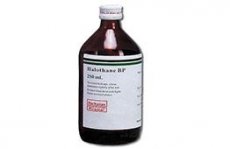Medical expert of the article
New publications
Preparations
Halothane
Last reviewed: 03.07.2025

All iLive content is medically reviewed or fact checked to ensure as much factual accuracy as possible.
We have strict sourcing guidelines and only link to reputable media sites, academic research institutions and, whenever possible, medically peer reviewed studies. Note that the numbers in parentheses ([1], [2], etc.) are clickable links to these studies.
If you feel that any of our content is inaccurate, out-of-date, or otherwise questionable, please select it and press Ctrl + Enter.

The drug is one of the representatives of halogen-containing anesthetics. Scientists synthesized Halothane in the 50s of the last century. It can be said that this is the most widely used anesthetic, although the problem of its hepatotoxicity was recently discovered and in developed countries Halothane began to be replaced by more modern drugs.
According to its physical and chemical properties, it is a transparent, colorless liquid. This liquid is mobile and heavy, nonflammable. The preparation is poorly soluble in water, but mixes well with ethanol and ether.
Release form
Halothane is available as an inhalation solution in 250 ml amber bottles.
Pharmacodynamics
Halothane is not used in its pure form for surgery. It is mixed with oxygen. Under the influence of such anesthesia, the central nervous system is suppressed and the person peacefully switches off. The surgical stage occurs in 4-6 minutes. Then the concentration of the drug is reduced, and then, depending on the course of the operation, the concentration of the drug can be increased. But this must be done slowly, so that there is no sharp drop in blood pressure. After the drug is stopped, the person begins to wake up in 3-5 minutes. If the anesthesia was short-term, then it completely passes in 5-10 minutes, and if long-term, then in 30-40. The drug also has a weak analgesic effect and relaxes the muscles. During anesthesia, intraocular pressure decreases, the cough and gag reflexes are blocked.
Pharmacokinetics
The drug is easily absorbed into the body from the respiratory tract and then quickly excreted by the lungs. Only a small portion of Halothane remains in the body in the form of metabolites, which are then excreted in the urine.
Dosing and administration
For anesthesia, inhalation devices with a reversible and non-reversible breathing circuit are used. Both of these devices are suitable for the use of Halothane. The dosage must be very precise. The initial concentration of Halothane for anesthesia is 0.5%, then it is increased to 3%. During the operation, the concentration of Halothane can fluctuate from 0.5 to 1.5%.
In this case, higher concentrations of Halothane are used for younger patients, and lower concentrations for older patients. But, in any case, it depends on the physical condition of the patient.
Use Halothane during pregnancy
Halothane should not be used in the first trimester of pregnancy. It is permissible only if there are vital indications. The fact is that Halothane easily passes the placental barrier and can cause depression in the fetus. Since Halothane causes a decrease in the tone of the uterine muscles, it is not used in obstetrics to avoid postpartum bleeding. During the studies, Halothane residues were found in breast milk, so after anesthesia with Halothane, breastfeeding is possible only after 24 hours.
Contraindications
The drug should not be used for anesthesia in people sensitive to fluorine-containing drugs, if a person has jaundice, hepatitis, or has liver dysfunction. This drug is contraindicated in cases of increased intracranial pressure, low blood pressure, or abnormal heart rhythm. Contraindications also include porphyria, myasthenia, hypercapnia, and thyrotoxicosis. As already mentioned, during pregnancy and childbirth. For dental procedures in adolescents and children, Halothane is used only in hospital settings.
Side effects Halothane
Halothane also has side effects. For the nervous system, it is dangerous due to increased intracranial pressure, increased cerebrospinal fluid pressure, and respiratory depression. When the Halothane anesthesia wears off, headaches, muscle tremors, and nausea may occur.
The cardiovascular system can react by lowering blood pressure and disrupting the heart rhythm.
Rarely, but there may be a liver reaction. In the first two weeks after anesthesia, the temperature may rise and mild jaundice may appear.
During childbirth, the tone of the uterus may decrease or bleeding may increase during an abortion.
Overdose
If an overdose of Halothane occurs, ventilation of the lungs with pure oxygen should be ensured; dantrolene is administered intravenously as an antidote. Symptoms of an overdose include decreased blood pressure, depression of the respiratory and vasomotor centers, and arrhythmia.
Interactions with other drugs
Halothane should be used with caution in combination with adrenaline. This may cause cardiac arrhythmia.
Halothane interacts well with muscle relaxants, but it is necessary to carefully monitor blood pressure and pulse rate. The dose of muscle relaxants should be reduced.
Ganglionic blockers in combination with Halothane are also used in smaller doses.
Storage conditions
Halothane should be stored in a tightly closed bottle, in a dark place. The storage temperature should not exceed 25ºС.
Keep children away from storage areas where Halothane in particular, and all medications in general, are stored.
Shelf life
Halothane is stored for 5 years. After this period, it is strictly forbidden to use it.
Attention!
To simplify the perception of information, this instruction for use of the drug "Halothane" translated and presented in a special form on the basis of the official instructions for medical use of the drug. Before use read the annotation that came directly to medicines.
Description provided for informational purposes and is not a guide to self-healing. The need for this drug, the purpose of the treatment regimen, methods and dose of the drug is determined solely by the attending physician. Self-medication is dangerous for your health.


 [
[